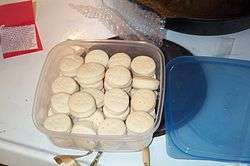Beaten biscuit
 | |
| Alternative names | Sea biscuits |
|---|---|
| Type | Biscuit |
| Place of origin | United States |
| Region or state | Southern United States |
| Main ingredients | Flour, salt, sugar, lard, cold water |
|
| |
Beaten biscuits are a Southern food from the United States, dating from the 19th century. They differ from regular American soft-dough biscuits in that they are more like hardtack. In New England they are called "sea biscuits",[1] as they were staples aboard whaling ships.[2]
Characteristics and preparation
The dough was originally made from flour, salt, sugar, lard, and cold water, and beaten with a hard object or against a hard surface. It is pricked with a fork prior to baking and cut smaller than a regular biscuit.[3] The prepared dough is baked at 325 °F (163 °C) for 20 minutes until tops are golden brown, but some bakers prefer a crisp, white biscuit that is baked with no browning.[4]
How long the biscuits are beaten varies from one recipe to the next, from "at least 15 minutes"[1] to "30 to 45 minutes."[3] The beating these biscuits undergo is severe: they are banged with a "rolling pin, hammer, or side of an axe";[1] or they are "pounded with a blunt instrument...[even] a tire iron will do...Granny used to beat 'em with a musket";[5] one book "instructs the cook to 'use boys to do it'"—that is, beat the biscuits vigorously "at least 200 times."[6] Besides ensuring the proper texture for the biscuit, "this beating also serves to vent the cook's weekly accumulation of pent-up frustrations."[5]
Uses
These biscuits were traditionally used in "ham biscuits", a traditional Southern canapé, where they are sliced horizontally and spread with butter, jelly, mustard and filled with pieces of country ham, or sopped up with gravy or syrup.[5][6] They are sometimes considered "Sunday biscuits" and can be stored for several months in an airtight container.[5] Beaten biscuits were once so popular that special machines, called biscuits brakes, were manufactured to knead the dough in home kitchens.[5] A biscuit brake typically consists of a pair of steel rollers geared together and operated by a crank, mounted on a small table with a marble top and cast iron legs.
Due to the amount of work required to make them, beaten biscuits are no longer popular.[7] Ham biscuits are still widely found in the United States but are made with standard biscuits or dinner rolls.[8]
See also
- List of American breads
- List of regional dishes of the United States
- Annie Fisher's "old missouri style"
References
- 1 2 3 Villas, James (2004). Biscuit bliss: 101 foolproof recipes for fresh and fluffy biscuits in just minutes. Harvard Common Press. p. 14. ISBN 978-1-55832-223-3.
- ↑ Biscuit bliss By James Villas page 14
- 1 2 "Beaten Biscuit". Encyclopedia. Food Network. Retrieved 2009-04-27.
- ↑ "Beaten Biscuits". Atlanta Magazine. March 29, 2013. Retrieved 2015-04-09.
- 1 2 3 4 5 Alvey, R. Gerald (1992). Kentucky Bluegrass country. UP of Mississippi. p. 261. ISBN 978-0-87805-544-9.
- 1 2 Claiborne, Craig; John T. Edge; Georgeanna Milam (2007). Craig Claiborne's Southern Cooking. Athens: U of Georgia P. p. 254. ISBN 978-0-8203-2992-5.
- ↑ Andrew Smith, Bruce Kraig, ed. (2013). The Oxford Encyclopedia of Food and Drink in America, Volume 1 (2nd ed.). Oxford University Press. p. 168. ISBN 978-0199734962.
- ↑ McWilliams, Mark (2012). The Story Behind the Dish: Classic American Foods. Greenwood. pp. 117, 118. ISBN 978-0313385094.